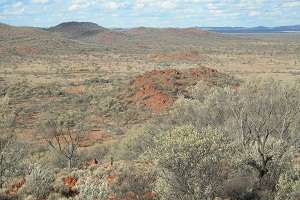Geological exploration reveals Australian super volcano

A geological survey team says an ancient super volcano exuded more than 450 cubic kilometres of molten magma in a single eruption, over what are now Ngaanyatjarra tribal lands.
Geochemist Dr Hugh Smithies says it is the largest super volcano he is aware of on the planet.
"It was active for likely in excess of 30 million years," he says.
"The typical lifespan of volcanic systems is usually measured in the many hundreds of thousands of years, up to a couple of million, but certainly 30 million is just extraordinary."
Dr Smithies says the eruption occurred at the point where three tectonic plates converged.
He says the earth's crust had been unusually hot in this location for some 200 million years beforehand, partly due to the North Australian, Western Australian and South Australian Cratons attempting to pull apart.
"I refer to it as a chronically frustrated rift," he says.
"This region has contained some of the hottest crust that the world's ever known.
"The magmas … produced in that prior 200 million years [were] very thorium rich … producing a lot of radiogenic heat keeping the area hot as well.
Dr Smithies and his team found the super volcano while exploring the Musgrave Ranges in the Western Desert for the Geological Survey of Western Australia.
"It involves systematic mapping and systematic geochemical sampling to try and gauge what the geochemical variations in the magmas were," he says.
"This was a particularly interesting part of the geology of the region that we spent a bit more time on than we normally do.
"The mapping allowed us to estimate the volumes of erupted material and that's where the super eruption concept comes from.
"They're defined as single eruptions that have volumes in excess of 450 cubic kilometres.
"The mapping allows us to establish the unit we're looking at, mapping as a single depositional unit, and to estimate the actual volumes.
He says super volcanoes are relatively rare phenomena, and this one may be unique for Australia.
The area is part of a fully-determined native title claim, and he was keen to acknowledge the traditional owners' participation.
"This whole project has been a joint project with the Indigenous people of that region," Dr Smithies says.
"In terms of economic potential there's obviously a lot of hyperthermal alteration associated with big volcanic systems and so it possibly heralds a hitherto unrecognised gold area that's potentially conducive to gold mineralisation."
More information: Notes:
The geological events referred to in this paper occurred approximately 1220 to 1020 million years ago.
Dr Smithies says there were likely to have been several eruptions that were of 'super' size and they occurred between circa 1078 and 1040 million years ago.
Provided by Science Network WA












.jpg)







